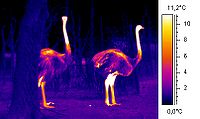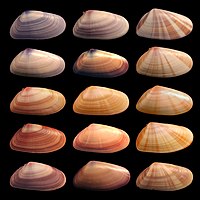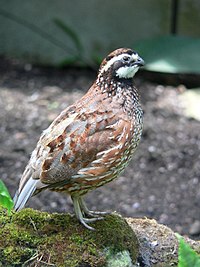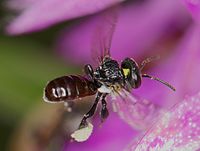
Reduced reproductive performance associated with warmer ambient temperatures during incubation in a winter‐breeding, food‐storing passerine
Sign Up to like & getrecommendations! Published in 2017 at "Ecology and Evolution"
DOI: 10.1002/ece3.2864
Abstract: Abstract Timing of reproduction can influence individual fitness whereby early breeders tend to have higher reproductive success than late breeders. However, the fitness consequences of timing of breeding may also be influenced by environmental conditions… read more here.
Keywords: reduced reproductive; brood; ambient temperatures; warmer ambient ... See more keywords

Did extreme nest predation favor the evolution of obligate brood parasitism in a duck?
Sign Up to like & getrecommendations! Published in 2022 at "Ecology and Evolution"
DOI: 10.1002/ece3.9251
Abstract: Abstract Obligate brood parasites depend entirely on other species to raise their offspring. Most avian obligate brood parasites have altricial offspring that require enormous amounts of posthatching parental care, and the large fecundity boost that… read more here.
Keywords: obligate brood; brood; parasitism; duck ... See more keywords

Experimental manipulation of brood size affects several levels of phenotypic variance in offspring and parent pied flycatchers
Sign Up to like & getrecommendations! Published in 2017 at "Behavioral Ecology and Sociobiology"
DOI: 10.1007/s00265-017-2315-3
Abstract: Parental provisioning of offspring should reflect selection on life history aspects of parenting and on foraging behavior. Life history and foraging theory generally make predictions about mean behavior, but some circumstances might favor changes in… read more here.
Keywords: brood; theory; variance; parent ... See more keywords

Carry-over effects of brood size on morphology, reproduction, and lifespan in barn swallows
Sign Up to like & getrecommendations! Published in 2018 at "Behavioral Ecology and Sociobiology"
DOI: 10.1007/s00265-018-2446-1
Abstract: Early life ecological conditions have well-documented short-term effects on offspring phenotype and survival, but the extent to which these effect carry-over into adulthood is much less known. Yet, unveiling such carry-over effects is essential to… read more here.
Keywords: carry effects; brood size; brood; size ... See more keywords

Nursery crowding does not influence offspring, but might influence parental, fitness in a phytotelm-breeding frog
Sign Up to like & getrecommendations! Published in 2019 at "Behavioral Ecology and Sociobiology"
DOI: 10.1007/s00265-019-2642-7
Abstract: One way parents shape the fitness prospects of their offspring is by providing a nursery. When parents divide a brood across several nurseries, they must assess not only the costs and benefits of multiple nurseries,… read more here.
Keywords: nursery crowding; brood; phytotelm; crowding influence ... See more keywords

Effects of fire management on northern bobwhite brood ecology
Sign Up to like & getrecommendations! Published in 2017 at "European Journal of Wildlife Research"
DOI: 10.1007/s10344-017-1078-5
Abstract: Northern Bobwhite Colinus virginianus chicks require ample invertebrates for growth and feather development. Early successional or resprouting vegetation provides invertebrates for chicks but may not provide other resources such as roosting and loafing cover that… read more here.
Keywords: northern bobwhite; brood; management; effects fire ... See more keywords

Brood provisioning and reproductive benefits in relation to habitat quality: a food supplementation experiment
Sign Up to like & getrecommendations! Published in 2018 at "Animal Behaviour"
DOI: 10.1016/j.anbehav.2018.05.009
Abstract: Food availability is a major characteristic of habitat quality, linking habitats with demographic parameters such as reproductive performance. Parent birds adjust their food provisioning to both habitat-specific food characteristics and the demands of their young.… read more here.
Keywords: quality; brood; habitat quality; food ... See more keywords

Alternation of nest visits varies with experimentally manipulated workload in brood-provisioning great tits
Sign Up to like & getrecommendations! Published in 2019 at "Animal Behaviour"
DOI: 10.1016/j.anbehav.2019.08.004
Abstract: In species with biparental care, the amount of care devoted to offspring is affected by the negotiation rules that the parents adopt. Recently, turn taking in provisioning visits has been proposed as a negotiation rule… read more here.
Keywords: manipulated workload; brood; nest visits; alternation ... See more keywords

The threat of pesticide and disease co-exposure to managed and wild bee larvae
Sign Up to like & getrecommendations! Published in 2022 at "International Journal for Parasitology: Parasites and Wildlife"
DOI: 10.1016/j.ijppaw.2022.03.001
Abstract: Brood diseases and pesticides can reduce the survival of bee larvae, reduce bee populations, and negatively influence ecosystem biodiversity. However, major gaps persist in our knowledge regarding the routes and implications of co-exposure to these… read more here.
Keywords: wild bee; exposure; brood; pesticide ... See more keywords

Effect of diet lipids and omega-6:3 ratio on honey bee brood development, adult survival and body composition.
Sign Up to like & getrecommendations! Published in 2020 at "Journal of insect physiology"
DOI: 10.1016/j.jinsphys.2020.104074
Abstract: Lipids have a key role in a variety of physiological functions in insects including energy, reproduction, growth and development. Whereas most of the required fatty acids can be synthesized endogenously, omega-3 and omega-6 polyunsaturated fatty… read more here.
Keywords: brood; honey; physiology; composition ... See more keywords

First confirmed report of a bacterial brood disease in stingless bees.
Sign Up to like & getrecommendations! Published in 2017 at "Journal of invertebrate pathology"
DOI: 10.1016/j.jip.2017.01.004
Abstract: Susceptibility to brood pathogens in eusocial stingless bees (Meliponini), alternative pollinators to honey bees, is unknown. Brood losses in managed colonies of the Australian stingless bee, Tetragonula carbonaria, were studied over 20months. We isolated a… read more here.
Keywords: brood; stingless bees; first confirmed; brood disease ... See more keywords